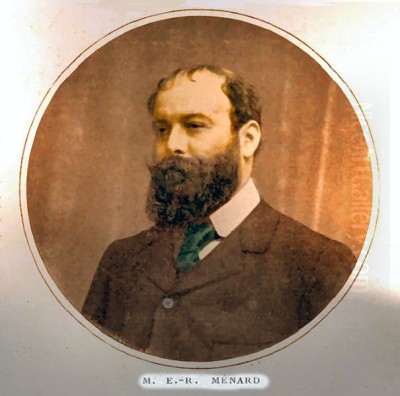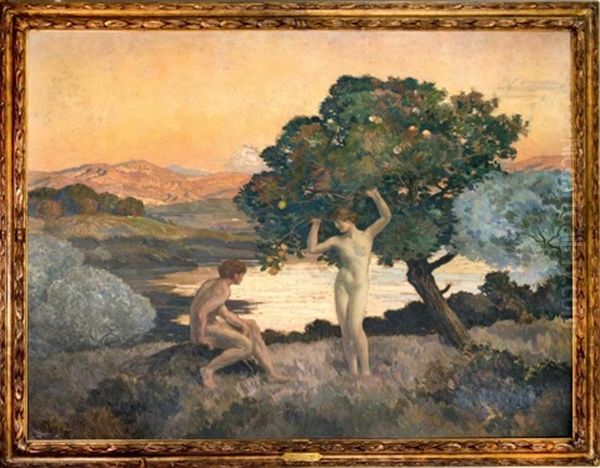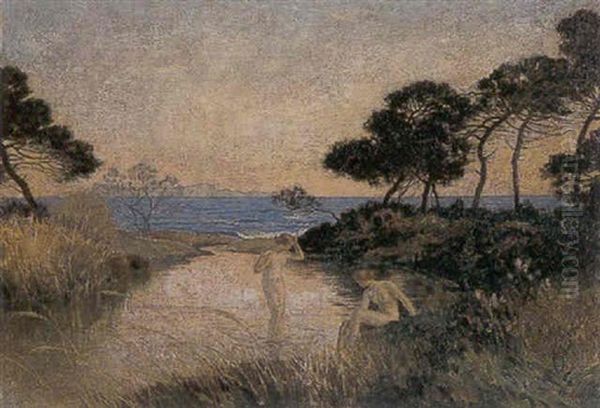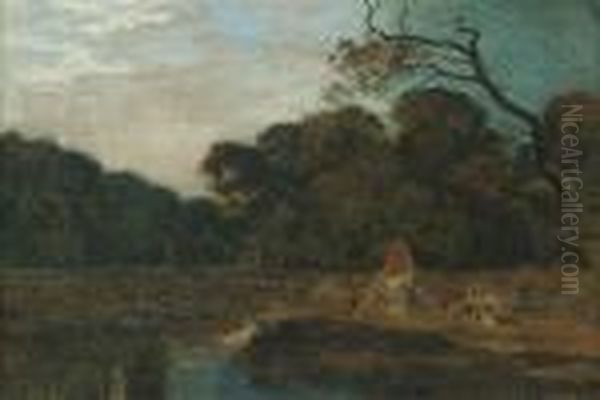
Émile-René Ménard stands as a significant figure in French art history, a painter whose career spanned the dynamic period from the late nineteenth century into the early twentieth. Born in Paris, France, Ménard carved a unique niche for himself, creating works celebrated for their harmonious blend of classical structure and a distinctly modern, often dreamlike, sensibility. He was primarily a painter, renowned for his evocative landscapes and compositions inspired by antiquity, establishing a reputation that resonated both within France and internationally. His art offers a tranquil vision, often bathed in the soft light of dawn or dusk, inviting contemplation and a sense of timeless peace.
Early Life and Artistic Formation
Sources present a slight ambiguity regarding Émile-René Ménard's birth year, citing either 1861 or 1862, though 1862 is more commonly accepted. He entered the world in Paris, into a family deeply immersed in the arts and intellectual pursuits. His father, René Joseph Ménard, was a painter, and his uncle, Louis-Nicolas Ménard, was a respected writer and chemist with a passion for Greek antiquity. This familial environment undoubtedly nurtured his artistic inclinations from a young age, exposing him early on to both the practice of painting and the allure of classical themes that would become central to his later work.
His formative years were significantly shaped by the artistic currents of the time. The family circle included artists associated with the Barbizon School, and Ménard absorbed the influence of masters like Jean-Baptiste-Camille Corot and Jean-François Millet. Their emphasis on landscape, atmospheric effects, and a certain poetic realism provided a foundational layer to his developing aesthetic. This early exposure instilled in him a deep appreciation for nature and its expressive potential, a theme that would remain constant throughout his career.

For his formal training, Ménard attended the prestigious Académie Julian in Paris, a renowned independent art school that served as an alternative to the official École des Beaux-Arts. While some sources note he received guidance directly from prominent academic painters like William-Adolphe Bouguereau and Paul Baudry, he was not formally enrolled at the Beaux-Arts itself. At the Académie Julian, he studied under figures such as Henri Lehmann, Baudry, and Bouguereau, absorbing the rigorous academic training in drawing and composition that underpinned the classical tradition. This education provided him with the technical mastery necessary to realize his artistic visions.
Forging a Signature Style
Ménard's artistic identity truly coalesced in his unique synthesis of seemingly disparate influences. He masterfully combined the discipline and clarity learned from his academic training and classical inspirations with a more modern, atmospheric approach reminiscent of Symbolism and, in some aspects, Impressionism. His style is often characterized by a profound sense of serenity, depicting idealized landscapes that feel both timeless and imbued with a gentle, melancholic beauty. He was not an Impressionist in the vein of Claude Monet or Camille Pissarro, focused on capturing fleeting moments of light, but he shared an interest in atmospheric effects and the evocative power of light.
A key element of Ménard's style is his treatment of light, particularly his fascination with the crepuscular hours – the soft, diffused light of dawn and dusk. His paintings often glow with a subtle luminescence, creating a dreamlike ambiance. This is not the harsh light of midday but a gentle radiance that softens forms and enhances the poetic mood. This focus on atmosphere aligns him with certain aspects of the Symbolist movement, which sought to evoke ideas and emotions rather than simply represent reality. Artists like Gustave Moreau or Odilon Redon explored the realm of dreams and myths, and while Ménard's style was distinct, he shared their interest in suggestive, rather than purely descriptive, imagery.
Furthermore, the influence of Pierre Puvis de Chavannes is palpable in Ménard's work, especially in his larger decorative compositions. Puvis de Chavannes was celebrated for his grand, simplified murals depicting allegorical and historical scenes with a calm, classical dignity and muted palette. Ménard adopted a similar sense of monumental calm and harmonious composition in his own decorative projects and larger easel paintings, integrating figures seamlessly into tranquil, often Arcadian, landscapes. This blend of classical order, atmospheric sensitivity, and poetic feeling became the hallmark of his mature style.
Arcadian Visions: Themes and Subjects

The subject matter favored by Émile-René Ménard consistently revolved around idealized landscapes, often infused with classical or mythological references. He sought to create visions of a harmonious world, a timeless Arcadia where humanity exists in peaceful coexistence with nature. While his landscapes were often inspired by his travels through France, Sicily, Greece, and Palestine, they were rarely straightforward topographical representations. Instead, he filtered these observations through his artistic sensibility, imbuing them with a sense of universal beauty and tranquility.
Mythological themes frequently appear in his work, featuring nymphs, deities, and heroes from Greek and Roman antiquity. However, these figures are typically presented not in moments of dramatic action, but rather as serene inhabitants of his idyllic landscapes. They become part of the overall harmony, symbols of a golden age or a connection to a timeless past. His approach was less narrative and more evocative, using these classical elements to enhance the poetic and symbolic resonance of the scene.
Pastoral life and the human figure integrated into nature were also recurring motifs. He depicted shepherds, bathers, or solitary figures contemplating the landscape, always emphasizing a sense of peace and quietude. These figures are often generalized, representing archetypes rather than specific individuals, contributing to the universal quality of his art. The overall impression is one of nostalgia for a simpler, more harmonious existence, a gentle melancholy pervading even the most sunlit scenes. His work consistently celebrates the beauty of the natural world, seen through a lens of classical idealism and poetic sensitivity.
Masterworks and Public Art
Throughout his career, Émile-René Ménard produced a significant body of work, including several paintings that are considered representative of his style and achievements. Among his most noted works is Hercule Chasseur de Lions (Hercules the Lion Hunter), painted around 1914. This piece exemplifies his engagement with classical mythology, depicting the heroic figure within a characteristically atmospheric landscape, showcasing his ability to blend epic themes with his signature serene style.
Another important work is Adam et Ève (Adam and Eve) from 1923. This painting, which was exhibited at the prestigious Carnegie International exhibition in Pittsburgh in 1925, reflects his pursuit of ideal beauty and his interest in foundational narratives, rendered with his typical grace and harmonious composition. It highlights his ability to tackle biblical themes with the same classicizing and poetic sensibility he applied to mythology.

His decorative talents are evident in works like La Ronde des Nymphes (The Waltz of the Naiads), a decorative panel created around 1908-1909 for the Law Faculty of the Sorbonne (University of Paris). Although later replaced by a work by his former teacher Henri Lehmann, this commission demonstrates his capacity for large-scale, integrated artistic statements. Femmes sur la Plage (Women on the Beach), dated 1921, showcases his skill in depicting figures within a coastal landscape, capturing the light and atmosphere with delicate sensitivity.
Beyond easel paintings, Ménard received several significant commissions for public murals and decorations from the French state, a testament to his established reputation. He created decorative schemes for various faculties at the Sorbonne, including the Law Faculty, the Chemistry Institute, and the École des Hautes Études. He also executed important murals for the Caisse d'Epargne (Savings Bank) in Marseille. These large-scale projects allowed him to fully express his vision of harmonious, classically inspired compositions integrated into architectural settings, marking high points in his official recognition.
Exhibition History and Reputation
Émile-René Ménard actively participated in the vibrant art scene of his time, regularly exhibiting his work and gaining considerable recognition. He was a frequent exhibitor at the official Salon des Artistes Français in Paris, the primary venue for artists seeking public acknowledgment and state patronage during much of his early career. His consistent presence there helped build his reputation among critics, collectors, and fellow artists.
His engagement extended beyond the traditional Paris Salon. In 1897, he participated in the Munich Secession Salon, aligning himself with progressive artists across Europe who sought alternatives to established academic structures. He also exhibited at the Salon de la Libre Esthétique in Brussels, another important venue for avant-garde and Symbolist art. These participations indicate his connection to broader European artistic movements and his desire to showcase his work within diverse contexts.
In 1921, Ménard exhibited alongside fellow painters Henri Martin and Edmond Aman-Jean at the twelfth Salon exhibition, further cementing his status as a respected figure in the French art world. While the provided texts don't detail specific collaborations, such joint exhibitions fostered dialogue and comparison among artists. His work garnered positive critical attention, often praised for its unique blend of tradition and modernity, its poetic atmosphere, and its technical refinement. This recognition translated into significant interest from collectors, not only in France but also in the United States and Great Britain, ensuring his work found appreciative audiences internationally during his lifetime.
Ménard in the Artistic Landscape
Placing Émile-René Ménard within the broader context of late 19th and early 20th-century French art reveals his unique position. He operated during a period of intense artistic innovation and diversification, marked by the successive waves of Impressionism, Post-Impressionism, Fauvism, and Cubism. While aware of these movements, Ménard largely charted his own course, drawing inspiration from tradition while subtly incorporating modern sensibilities.
His connection to the Barbizon school (Corot, Millet, Théodore Rousseau, Charles-François Daubigny) is evident in his love for landscape and atmospheric effects. However, he moved beyond their more naturalistic approach towards a more idealized and symbolic representation of nature. His academic training under figures like Bouguereau and Lehmann provided a strong foundation in classical composition and figure drawing, which he never abandoned, unlike many avant-garde artists. Yet, he softened the often rigid or overly polished finish of academic art with a more painterly touch and atmospheric depth.
Compared to the Impressionists like Monet or Renoir, Ménard's work appears more structured, timeless, and less focused on capturing the fleeting moment. His affinity lies more closely with the Symbolist movement, particularly in his evocative moods, dreamlike atmospheres, and use of mythological or allegorical themes, echoing aspects found in the work of Gustave Moreau or Puvis de Chavannes. However, Ménard maintained a stronger connection to observable reality and classical harmony than some of the more esoteric Symbolists like Odilon Redon. He can be seen alongside contemporaries like Henri Martin or Edmond Aman-Jean, who also navigated a path between tradition and modernity, often incorporating Symbolist or Intimist elements into decorative compositions. He stands apart from the stark academicism of painters like Jean-Léon Gérôme, yet remains distinct from the radical formal experiments of the emerging avant-garde.
Market Presence and Enduring Legacy
Émile-René Ménard's work has maintained a consistent presence in the art market since his death in 1930. While perhaps not reaching the stratospheric prices of some of his Impressionist or Post-Impressionist contemporaries, his paintings are sought after by collectors who appreciate his unique aesthetic and historical significance. Auction results reflect this steady interest. For instance, his painting Femmes sur la Plage was offered at auction by Millon in Paris in 2006 with an estimate of €4,000 to €6,000, indicating a respectable market value. Other major works, such as Hercule Chasseur de Lions and Adam et Ève, also appear periodically at auction, attesting to their desirability.
His legacy rests on his successful synthesis of classical ideals with a modern, poetic sensibility. He is remembered as a master of atmosphere and light, capable of evoking profound tranquility and timeless beauty in his landscapes and figure compositions. Critics and art historians recognize him as an important figure within the Symbolist-influenced currents of French art, bridging the academic tradition of the 19th century with the evolving artistic landscape of the early 20th century. He represented a form of "modern spirit" that valued harmony, beauty, and emotional resonance over radical disruption.
His works are held in numerous public collections, including the Musée d'Orsay in Paris, ensuring his contribution to French art history remains accessible. He is valued for his technical skill, his consistent vision, and his ability to create serene, Arcadian worlds that offer respite and contemplation. Ménard carved out a distinctive path, creating art that speaks of enduring human desires for peace, beauty, and harmony with the natural world.
Conclusion
Émile-René Ménard remains a compelling figure in the narrative of French art. As a painter deeply influenced by his artistic upbringing and classical training, yet responsive to the atmospheric and symbolic currents of his time, he forged a unique and enduring style. His canvases, often depicting idyllic landscapes bathed in the ethereal light of dawn or dusk and populated by serene figures from myth or pastoral life, offer a vision of timeless harmony. Through his numerous paintings, participation in major exhibitions, and significant public commissions, Ménard established himself as a respected artist whose work resonated with collectors and critics alike. His legacy is that of a painter who successfully navigated the complex artistic landscape of his era, creating a body of work celebrated for its technical mastery, poetic sensibility, and tranquil beauty, securing his place as a significant bridge between 19th-century tradition and 20th-century modernity.